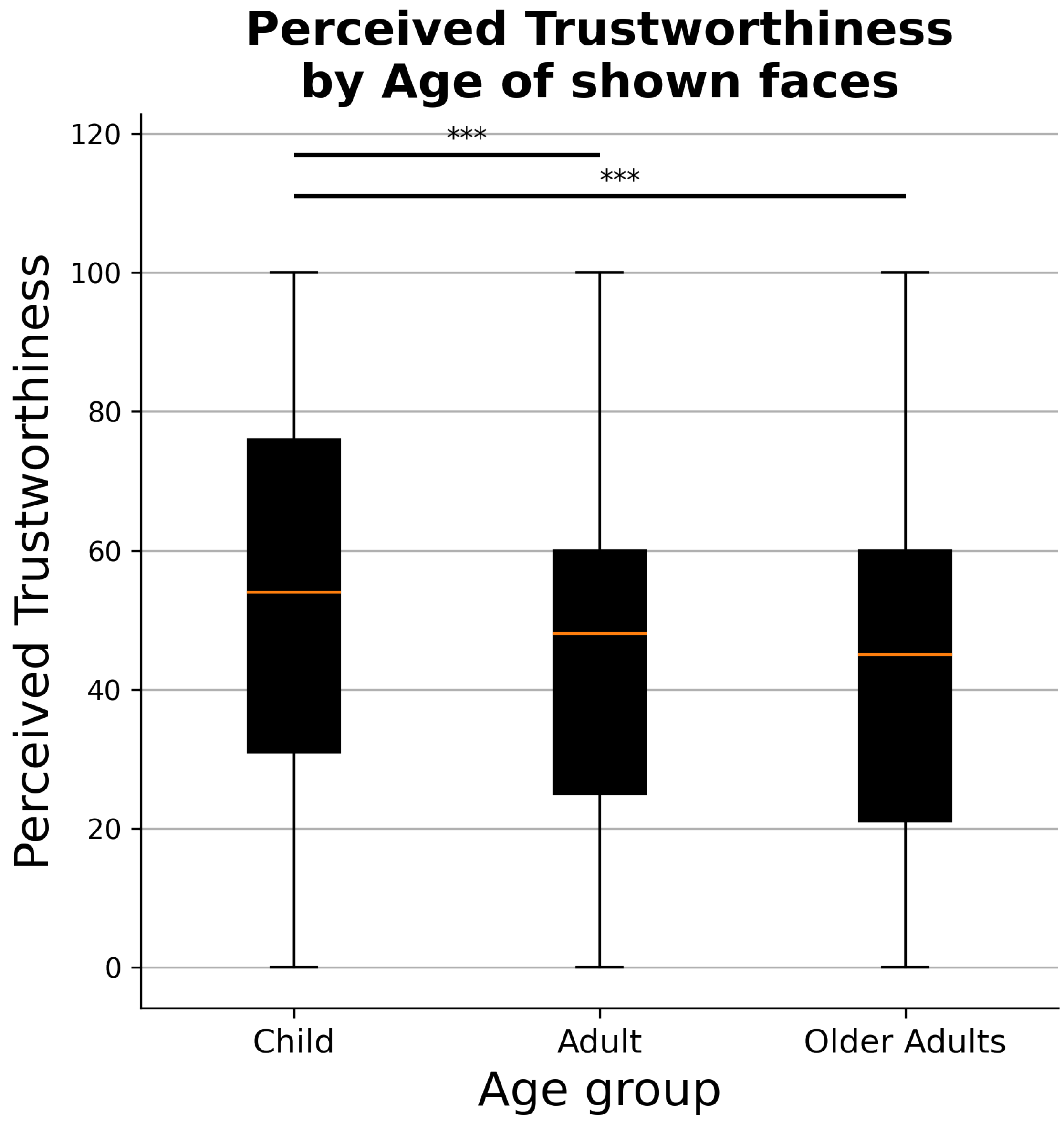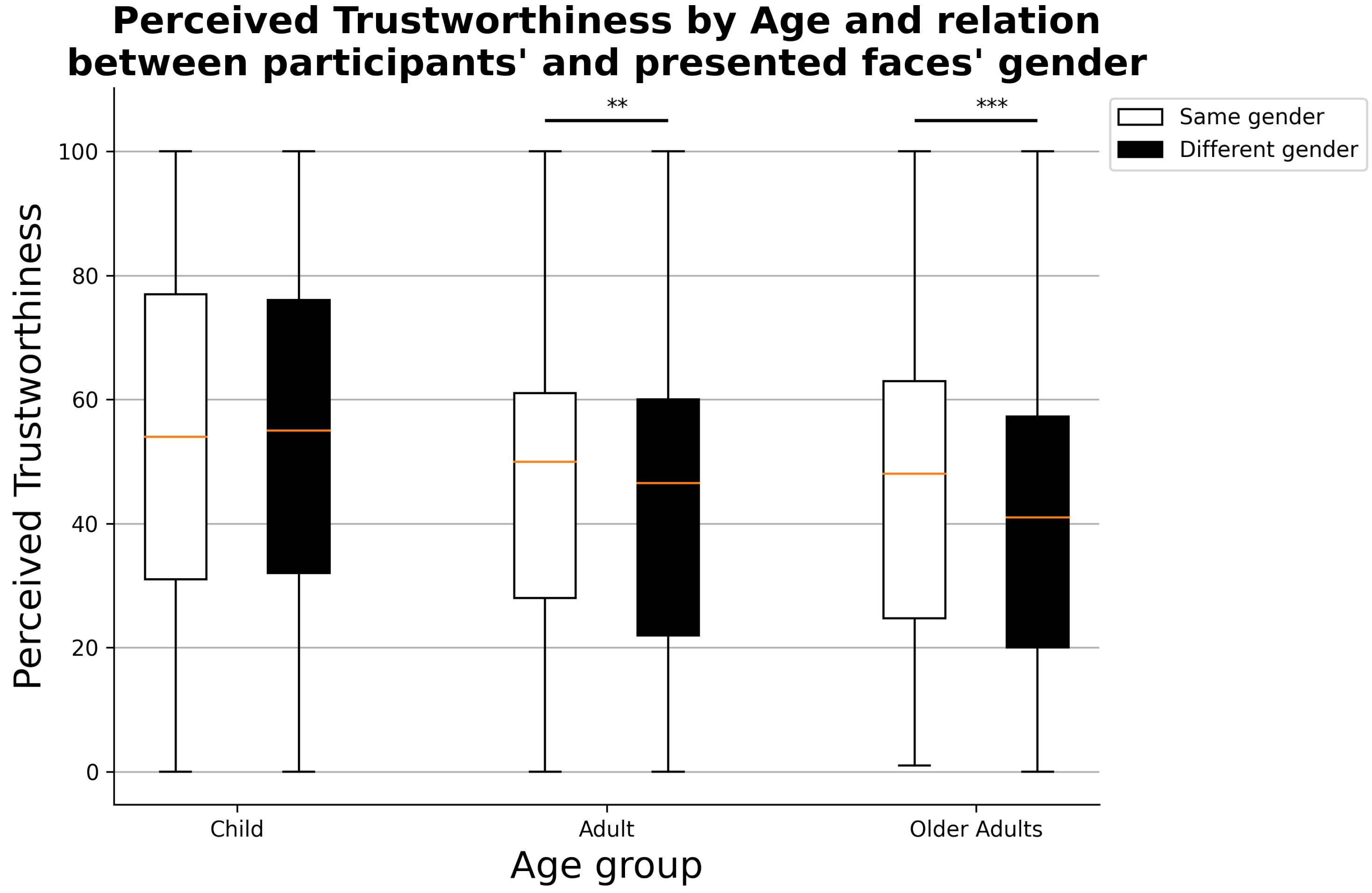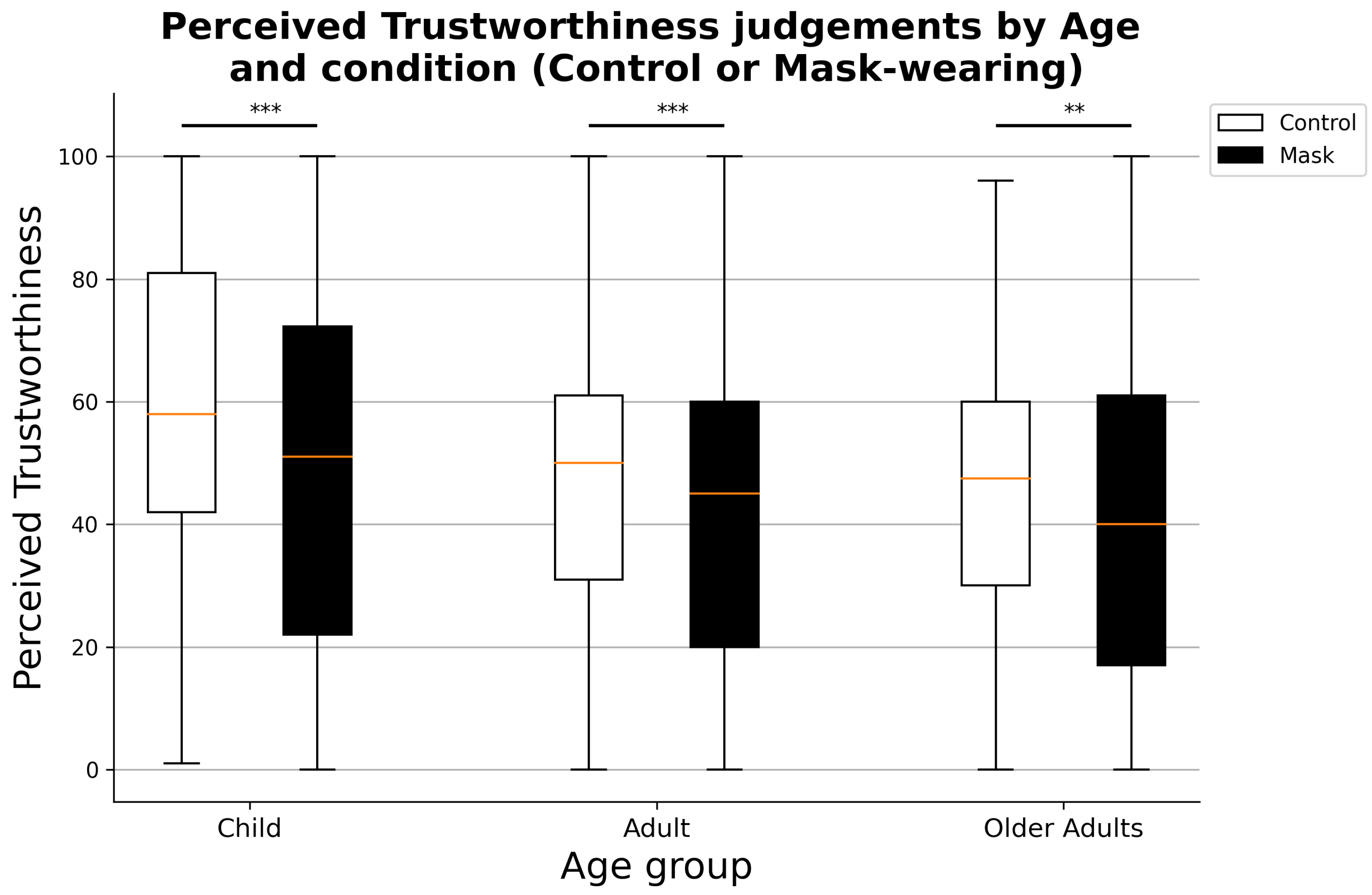Reduced Perceived Trustworthiness during Face Mask Wearing
Abstract
:1. Introduction
Aim and Hypotheses
2. Materials and Methods
2.1. Experimental Design
2.2. Analytic Plan
2.3. Participants
3. Results
4. Discussion
Limitations
5. Conclusions
Author Contributions
Funding
Institutional Review Board Statement
Informed Consent Statement
Data Availability Statement
Conflicts of Interest
References
- Venturoso, L.; Gabrieli, G.; Truzzi, A.; Azhari, A.; Setoh, P.; Bornstein, M.H.; Esposito, G. Effects of baby schema and mere exposure on explicit and implicit face processing. Front. Psychol. 2019, 10, 2649. [Google Scholar] [CrossRef] [PubMed]
- Navarini, N.; Venturoso, L.G.; Truzzi, A.; Lim, M.; Setoh, P.; Esposito, G. The Influence of Baby Schema Effect and Mere Exposure Effect on Implicit and Explicit Face Processing: A Follow-Up Study. Exp. Psychol. 2021, 14, 124–140. [Google Scholar]
- Toma, C.L. Counting on friends: Cues to perceived trustworthiness in Facebook profiles. In Proceedings of the Eighth International AAAI Conference on Weblogs and Social Media, Ann Arbor, MI, USA, 1–4 June 2014. [Google Scholar]
- Hollingworth, H.L. Judging Human Character; D. Appleton & Company: New York, NY, USA, 1922. [Google Scholar]
- Laird, D.A. The Psychology of Selecting Men; McGraw-Hill Book Company Incorporated: New York, NY, USA, 1927. [Google Scholar]
- Carter, J.A. Impressions of counselors as a function of counselor physical attractiveness. J. Couns. Psychol. 1978, 25, 28. [Google Scholar] [CrossRef]
- Shinners, E. Effects of the “what is beautiful is good” stereotype on perceived trustworthiness. UW-L J. Undergrad. Res. 2009, 12, 1–5. [Google Scholar]
- Gabrieli, G.; Lee, A.; Setoh, P.; Esposito, G. An analysis of the generalizability and stability of the halo effect during the COVID-19 pandemic outbreak. Front. Psychol. 2021, 12, 547. [Google Scholar] [CrossRef] [PubMed]
- Cash, T.F.; Begley, P.J.; McCown, D.A.; Weise, B.C. When counselors are heard but not seen: Initial impact of physical attractiveness. J. Couns. Psychol. 1975, 22, 273. [Google Scholar] [CrossRef]
- Darby, B.W.; Jeffers, D. The effects of defendant and juror attractiveness on simulated courtroom trial decisions. Soc. Behav. Personal. Int. J. 1988, 16, 39–50. [Google Scholar] [CrossRef]
- Eagly, A.H.; Ashmore, R.D.; Makhijani, M.G.; Longo, L.C. What is beautiful is good, but…: A meta-analytic review of research on the physical attractiveness stereotype. Psychol. Bull. 1991, 110, 109. [Google Scholar] [CrossRef]
- Carollo, A.; Bizzego, A.; Gabrieli, G.; Wong, K.K.Y.; Raine, A.; Esposito, G. I’m alone but not lonely. U-shaped pattern of perceived loneliness during the COVID-19 pandemic in the UK and Greece. medRxiv 2020. [Google Scholar] [CrossRef]
- Venkatesh, A.; Edirappuli, S. Social distancing in covid-19: What are the mental health implications? BMJ 2020, 369. [Google Scholar] [CrossRef] [Green Version]
- Chu, D.K.; Akl, E.A.; Duda, S.; Solo, K.; Yaacoub, S.; Schünemann, H.J.; El-harakeh, A.; Bognanni, A.; Lotfi, T.; Loeb, M.; et al. Physical distancing, face masks, and eye protection to prevent person-to-person transmission of SARS-CoV-2 and COVID-19: A systematic review and meta-analysis. Lancet 2020, 395, 1973–1987. [Google Scholar] [CrossRef]
- Coclite, D.; Napoletano, A.; Gianola, S.; Del Monaco, A.; D’Angelo, D.; Fauci, A.; Iacorossi, L.; Latina, R.; La Torre, G.; Mastroianni, C.M.; et al. Face mask use in the community for reducing the spread of COVID-19: A systematic review. Front. Med. 2020, 7, 594269. [Google Scholar] [CrossRef] [PubMed]
- Zebrowitz, L.A. First impressions from faces. Curr. Dir. Psychol. Sci. 2017, 26, 237–242. [Google Scholar] [CrossRef]
- McArthur, L.Z.; Baron, R.M. Toward an ecological theory of social perception. Psychol. Rev. 1983, 90, 215. [Google Scholar] [CrossRef]
- Hassin, R.; Trope, Y. Facing faces: Studies on the cognitive aspects of physiognomy. J. Personal. Soc. Psychol. 2000, 78, 837. [Google Scholar] [CrossRef]
- Todorov, A.; Mandisodza, A.N.; Goren, A.; Hall, C.C. Inferences of competence from faces predict election outcomes. Science 2005, 308, 1623–1626. [Google Scholar] [CrossRef] [Green Version]
- Hall, C.C.; Ariss, L.; Todorov, A. The illusion of knowledge: When more information reduces accuracy and increases confidence. Organ. Behav. Hum. Decis. Process. 2007, 103, 277–290. [Google Scholar] [CrossRef]
- Acar-Burkay, S.; Fennis, B.M.; Warlop, L. Trusting others: The polarization effect of need for closure. J. Personal. Soc. Psychol. 2014, 107, 719. [Google Scholar] [CrossRef] [Green Version]
- Reis, H.T.; Maniaci, M.R.; Caprariello, P.A.; Eastwick, P.W.; Finkel, E.J. Familiarity does indeed promote attraction in live interaction. J. Personal. Soc. Psychol. 2011, 101, 557. [Google Scholar] [CrossRef] [PubMed]
- Theiss, J.A.; Solomon, D.H. Parsing the mechanisms that increase relational intimacy: The effects of uncertainty amount, open communication about uncertainty, and the reduction of uncertainty. Hum. Commun. Res. 2008, 34, 625–654. [Google Scholar] [CrossRef]
- Grundmann, F.; Epstude, K.; Scheibe, S. Face masks reduce emotion-recognition accuracy and perceived closeness. PLoS ONE 2021, 16, e0249792. [Google Scholar] [CrossRef] [PubMed]
- Cartaud, A.; Quesque, F.; Coello, Y. Wearing a face mask against Covid-19 results in a reduction of social distancing. PLoS ONE 2020, 15, e0243023. [Google Scholar] [CrossRef] [PubMed]
- Jones, D. A WEIRD View of Human Nature Skews Psychologists’ Studies; American Association for the Advancement of Science: Washington, DC, USA, 2010. [Google Scholar]
- Henrich, J.; Heine, S.J.; Norenzayan, A. Beyond WEIRD: Towards a broad-based behavioral science. Behav. Brain Sci. 2010, 33, 111. [Google Scholar] [CrossRef]
- Gabrieli, G.; Lim, Y.Y.; Esposito, G. Influences of Social Distancing and attachment styles on the strength of the Halo Effect. PLoS ONE 2021, 16, e0256364. [Google Scholar] [CrossRef]
- Gabrieli, G.; Ng, S.; Esposito, G. Hacking Trust: The Presence of Faces on Automated Teller Machines (ATMs) Affects Trustworthiness. Behav. Sci. 2021, 11, 91. [Google Scholar] [CrossRef] [PubMed]
- Gabrieli, G.; Esposito, G. Impact of Face Mask Wearing on the Strength of the Halo Effect (Aesthetics × Trustworthiness). Available online: https://doi:10.17605/OSF.IO/VS53B (accessed on 17 November 2021). [CrossRef]
- Collova, J.R.; Sutherland, C.A.; Rhodes, G. Testing the functional basis of first impressions: Dimensions for children’s faces are not the same as for adults’ faces. J. Personal. Soc. Psychol. 2019, 117, 900. [Google Scholar] [CrossRef] [Green Version]
- Oosterhof, N.N.; Todorov, A. The functional basis of face evaluation. Proc. Natl. Acad. Sci. USA 2008, 105, 11087–11092. [Google Scholar] [CrossRef] [Green Version]
- Wetzel, C.G.; Wilson, T.D.; Kort, J. The halo effect revisited: Forewarned is not forearmed. J. Exp. Soc. Psychol. USA 1981, 17, 427–439. [Google Scholar] [CrossRef]
- Li, C.; Turmunkh, U.; Wakker, P.P. Trust as a decision under ambiguity. Exp. Econ. 2019, 22, 51–75. [Google Scholar] [CrossRef] [Green Version]
- Ma, X.; Hancock, J.T.; Lim Mingjie, K.; Naaman, M. Self-disclosure and perceived trustworthiness of Airbnb host profiles. In Proceedings of the 2017 ACM Conference on Computer Supported Cooperative Work and Social Computing, Portland, OR, USA, 25 February–1 March 2017; pp. 2397–2409. [Google Scholar]
- Castano, E.; Yzerbyt, V.; Paladino, M.P.; Sacchi, S. I belong, therefore, I exist: Ingroup identification, ingroup entitativity, and ingroup bias. Personal. Soc. Psychol. Bull. 2002, 28, 135–143. [Google Scholar] [CrossRef] [Green Version]
- Mullen, B.; Brown, R.; Smith, C. Ingroup bias as a function of salience, relevance, and status: An integration. Eur. J. Soc. Psychol. 1992, 22, 103–122. [Google Scholar] [CrossRef]
- Karras, T.; Laine, S.; Aila, T. A style-based generator architecture for generative adversarial networks. In Proceedings of the IEEE Conference on Computer Vision and Pattern Recognition, Long Beach, CA, USA, 16–20 June 2019; pp. 4401–4410. [Google Scholar]
- Wang, R.; Ma, L.; Juefei-Xu, F.; Xie, X.; Wang, J.; Liu, Y. Fakespotter: A simple baseline for spotting ai-synthesized fake faces. arXiv 2019, arXiv:1909.06122. [Google Scholar]
- Faul, F.; Erdfelder, E.; Lang, A.G.; Buchner, A. G* Power 3: A flexible statistical power analysis program for the social, behavioral, and biomedical sciences. Behav. Res. Methods 2007, 39, 175–191. [Google Scholar] [CrossRef] [PubMed]
- Faul, F.; Erdfelder, E.; Buchner, A.; Lang, A.G. Statistical power analyses using G* Power 3.1: Tests for correlation and regression analyses. Behav. Res. Methods 2009, 41, 1149–1160. [Google Scholar] [CrossRef] [Green Version]



| Ethnicity | Gender | N | Mean Age (±std) |
|---|---|---|---|
| Caucasian | Men | 9 | 28.33 ± 7.00 |
| Caucasian | Women | 26 | 30.27 ± 10.11 |
| Asian | Men | 22 | 22.05 ± 2.73 |
| Asian | Women | 14 | 25.00 ± 7.93 |
| Sum Sq | Df | F Value | p | ||
|---|---|---|---|---|---|
| Ethnicity | 0.008 | 1 | 0.0462 | 0.8299 | 5.84 |
| Age | 0.196 | 2 | 0.5428 | 0.5813 | 1.37 |
| Gender | 0.254 | 1 | 1.4050 | 0.2362 | 1.77 |
| Condition | 0.076 | 1 | 0.4172 | 0.5185 | 5.27 |
| Gender Age | 0.523 | 2 | 1.4437 | 0.2367 | 3.64 |
| Ethnicity Age | 0.464 | 2 | 1.2828 | 0.2778 | 3.23 |
| Gender Ethnicity | 0.057 | 1 | 0.3124 | 0.5764 | 3.95 |
| Age Condition | 0.500 | 2 | 1.3823 | 0.2516 | 3.48 |
| Gender Condition | 0.004 | 1 | 0.0228 | 0.8800 | 2.88 |
| Ethnicity Condition | 0.003 | 1 | 0.0170 | 0.8962 | 2.15 |
| Ethnicity Gender Age | 0.397 | 2 | 1.0970 | 0.3344 | 2.77 |
| Gender Age Condition | 0.590 | 2 | 1.6304 | 0.1965 | 4.11 |
| Ethnicity Age Condition | 0.146 | 2 | 0.4044 | 0.6675 | 1.02 |
| Ethnicity Gender Condition | 0.106 | 1 | 0.5834 | 0.4452 | 7.37 |
| Ethnicity Gender Age Condition | 0.199 | 2 | 0.5500 | 0.5772 | 1.39 |
| Sum Sq | Df | F value | p | ||
|---|---|---|---|---|---|
| Ethnicity | 503 | 1 | 0.7378 | 0.3904 | 1.09 |
| Age | 190,887 | 2 | 139.9388 | <0.0001 *** | 0.04 |
| Gender | 8699 | 1 | 12.7539 | 0.0004 *** | 1.87 |
| Condition | 51,064 | 1 | 74.8705 | <0.0001 *** | 0.01 |
| Age Gender | 5545 | 2 | 4.0650 | 0.01720 * | 1.20 |
| Age Ethnicity | 996 | 2 | 0.7302 | 0.4818 | 2.15 |
| Gender Ethnicity | 569 | 1 | 0.8348 | 0.3609 | 1.23 |
| Age Condition | 7674 | 2 | 5.6257 | 0.0036 ** | 1.65 |
| Gender Condition | 2 | 1 | 0.0023 | 0.9621 | 3.33 |
| Ethnicity Condition | 180 | 1 | 0.2646 | 0.6070 | 3.90 |
| Ethnicity Gender Age | 151 | 2 | 0.1108 | 0.8951 | 3.26 |
| Gender Age Condition | 988 | 2 | 0.7246 | 0.4846 | 2.13 |
| Ethnicity Age Condition | 989 | 2 | 0.7253 | 0.4842 | 2.14 |
| Ethnicity Gender Condition | 111 | 1 | 0.1626 | 0.6868 | 2.39 |
| Ethnicity Gender Age Condition | 416 | 2 | 0.3051 | 0.7370 | 8.98 |
Publisher’s Note: MDPI stays neutral with regard to jurisdictional claims in published maps and institutional affiliations. |
© 2021 by the authors. Licensee MDPI, Basel, Switzerland. This article is an open access article distributed under the terms and conditions of the Creative Commons Attribution (CC BY) license (https://creativecommons.org/licenses/by/4.0/).
Share and Cite
Gabrieli, G.; Esposito, G. Reduced Perceived Trustworthiness during Face Mask Wearing. Eur. J. Investig. Health Psychol. Educ. 2021, 11, 1474-1484. https://doi.org/10.3390/ejihpe11040105
Gabrieli G, Esposito G. Reduced Perceived Trustworthiness during Face Mask Wearing. European Journal of Investigation in Health, Psychology and Education. 2021; 11(4):1474-1484. https://doi.org/10.3390/ejihpe11040105
Chicago/Turabian StyleGabrieli, Giulio, and Gianluca Esposito. 2021. "Reduced Perceived Trustworthiness during Face Mask Wearing" European Journal of Investigation in Health, Psychology and Education 11, no. 4: 1474-1484. https://doi.org/10.3390/ejihpe11040105
APA StyleGabrieli, G., & Esposito, G. (2021). Reduced Perceived Trustworthiness during Face Mask Wearing. European Journal of Investigation in Health, Psychology and Education, 11(4), 1474-1484. https://doi.org/10.3390/ejihpe11040105






